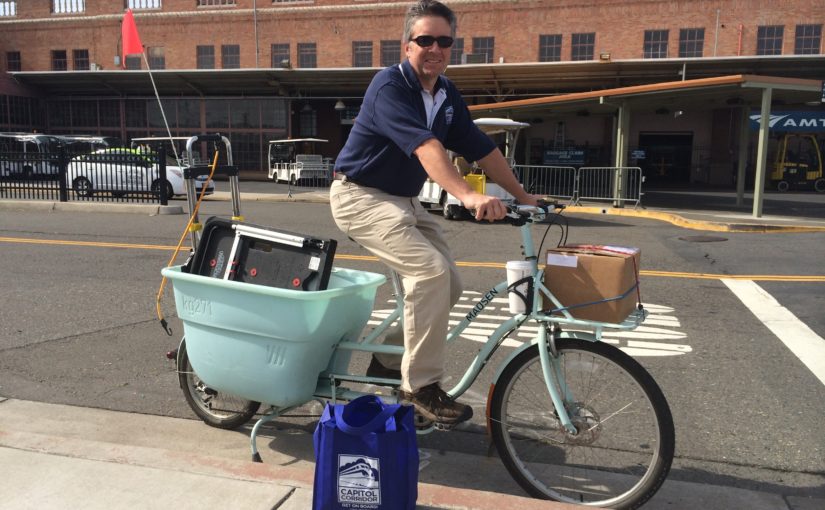There are a lot of people at the Capitol Corridor who keep the trains running day in and day out, and make sure riders are as happy and informed as possible. There’s one guy on the team though who does more than that. Meet Jim Allison, Manager of Planning. If you take your bike on the train and use our free on board Wi-Fi, you can thank Jim for that, but he’s also our resident dreamer and futurist as he looks down the road, years and even decades ahead, to plan for the services and features of our next generation of riders. Learn a little more about Jim and what he does in our Staff Spotlight interview conducted by Savannah Kuang, the Capitol Corridor’s Climate Corps Fellow.
SK: What is your role at the Capitol Corridor, and what does that entail?
JA: I am the Manager of Planning at the Capitol Corridor. I work on grants, project management, policy, and, in short, plans for things in the future. Generally, I will analyze ridership trends when looking at service changes and things like that. Or, on the non-traditional railroad projects, I will look at ways to match new technology initiatives with our ridership based on the characteristics and demographics of our customers. These would be services like Wi-Fi on the train and On Board Information Systems, which will be coming in the near future.
SK: What gets you out of bed in the morning?
JA: An alarm clock.
SK: Funny, funny…but what motivates you to come to work?
JA: What motivates me is trying to work on changes that our riders want and need; changes that will improve the customer experience – and not just for today, but for generations to come.
SK: Since you are always looking ahead towards the future, where do you see the Capitol Corridor in the next 25 years?
JA: In the next 25 years, I’m going to predict that the Capitol Corridor service will be kind of blended into a Northern California/State service that is integrated across communities with intercity rail, commuter rail, and high-speed rail type services. Customers will still travel along the Capitol Corridor route, but it may not be branded quite that way. It will be more like a system that you see in Europe or Asia.
SK: If you had unlimited funding, what’s the one thing you would change or add to the Capitol Corridor tomorrow?
JA: I guess if I had to pick one thing, it would be to have complete ticket integration for customers using all types of transit. There would be one ticket, and you could get it and pay for it on your smartphone or other device. This integration would not only assist you with paying for transportation, but it would also work with other things in life that provide you value. Let’s say you wanted to go from point A to point B, and at point B you’re going to watch a movie – with this integration technology, you’d pay for everything all together at the same time.
SK: As a regular Capitol Corridor rider, what do you enjoy most about your time on the train?
JA: I have to say the Wi-Fi. I really like having it on the train, and it makes the time more productive.
When it’s not working, which I work to make as rare as possible, it drives me crazy because I feel like I’m missing something.
SK: You’re a cyclist who lives in Sacramento, and you’re also a craft beer enthusiast. What are your recommendations for breweries in the Sacramento area?
JA: I’d have to say Bike Dog, Track 7, New Helvetia, American River, and Sactown Union. These are all within biking distance from where I live, and you feel like you’re in a local setting. All of these breweries have good and interesting beer, and they care about the product they put out. I also like that I’m able to ride my town bike to and from them. It’s fun to go to these spots and hang out with friends or family.
SK: When you’re not planning the future of train travel in Northern California, do you have a favorite travel or vacation spot?
JA: I don’t really have a favorite vacation spot, but generally I like to visit places where I can be “embedded” with the locals, so I can experience how they live day to day. It could be a city or a beach community—doesn’t matter.
SK: Okay, but if you had to pick one place, where would it be?
JA: If I had to choose one place, it would have to be London. I’ve only been to London for work, but I think it’s a fascinating place to experience and I’d like to learn more about this huge megapolis and see what makes it tick. The time I have spent there I feel like I just scratched the surface and being a transport fan, it has one of the most amazing daily migrations of massive numbers of people.
SK: As we finish up here, do you have any interesting planning facts you’d like to share with us?
JA: Probably the most interesting one related to our service is that the Capitol Corridor has one of the highest bike mode access shares of any transit system in the country. Based on our latest rider survey, 13% of our passengers access our service via bicycle. That’s an impressive statistic, and the fact that it’s so high definitely affects how we approach and plan for service. We’re constantly working to meet this incredible demand by finding ways to increase places where people can store their bikes either on the train or at the station. Unfortunately, the options to keep up with the demand don’t happen very quickly – working in the public sphere everything takes a bit longer than most people believe it should.

